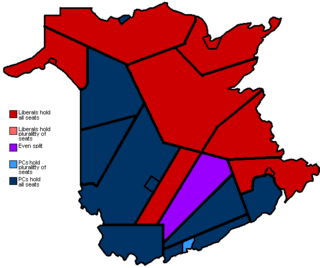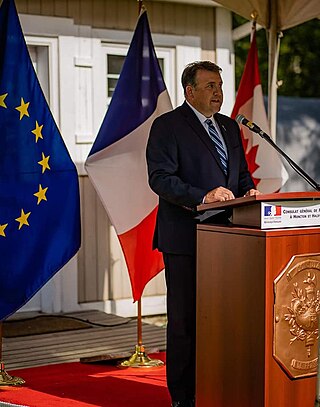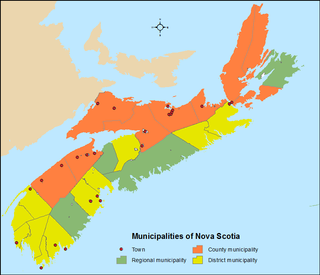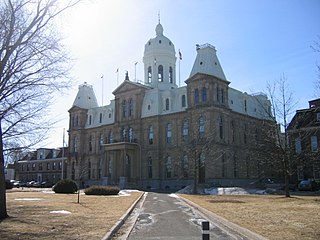Related Research Articles

New Brunswick is one of the thirteen provinces and territories of Canada. It is one of the three Maritime provinces and one of the four Atlantic provinces. It is the only province with both English and French as its official languages.

Local government is a generic term for the lowest tiers of public administration within a particular sovereign state. This particular usage of the word government refers specifically to a level of administration that is both geographically localised and has limited powers. While in some countries, "government" is normally reserved purely for a national administration (government), the term local government is always used specifically in contrast to national government – as well as, in many cases, the activities of sub-national, first-level administrative divisions. Local governments generally act only within powers specifically delegated to them by law and/or directives of a higher level of government. In federal states, local government generally comprises a third or fourth tier of government, whereas in unitary states, local government usually occupies the second or third tier of government.
Louis Joseph Robichaud, popularly known as "Little Louis" or "P'tit-Louis", was the second Acadian premier of New Brunswick, serving from 1960 to 1970.

Shawn Michael Graham is a Canadian politician, who served as the 31st premier of New Brunswick from 2006 to 2010. He was elected leader of the New Brunswick Liberal Party in 2002 and became premier after his party captured a majority of seats in the 2006 election. After being elected, Graham initiated a number of changes to provincial policy especially in the areas of health care, education and energy. His party was defeated in the New Brunswick provincial election held September 27, 2010, and Graham resigned as Liberal leader on November 9, 2010.

The New Brunswick Liberal Association, more popularly known as the New Brunswick Liberal Party or Liberal Party of New Brunswick, is one of the two major provincial political parties in New Brunswick, Canada. The party descended from both the Confederation Party and the Anti-Confederation Party whose members split into left-wing and right-wing groups following the creation of Canada as a nation in 1867.

The Department of Health is a part of the Government of New Brunswick. It is charged with administration and delivery of public healthcare in New Brunswick.

The 1967 New Brunswick general election was held on October 23, 1967, to elect 58 members to the 46th New Brunswick Legislative Assembly, the governing house of the province of New Brunswick, Canada.

The municipal government of Toronto is the local government responsible for administering the city of Toronto in the Canadian province of Ontario. Its structure and powers are set out in the City of Toronto Act.
A local service district (LSD) was a provincial administrative unit for the provision of local services in the Canadian province of New Brunswick. LSDs originally covered areas of the province that maintained some services but were not made municipalities when the province's former county municipalities were dissolved at the start of 1967; eventually all of rural New Brunswick was covered by the LSD system. They were defined in law by the Local Service Districts Regulation of the Municipalities Act. In 2017, the Municipalities Act was replaced by the Local Governance Act, which continued the Local Service Districts Regulation.
Local government in Canada can be defined as all elected local authorities which are legally empowered to make decisions on behalf of its electors, excluding the federal government, provincial and territorial governments, and First Nations, Métis and Inuit governments. This can include municipalities, school boards, health authorities, and so on.

New Brunswick has had, since the Legislative Council was abolished by an act passed on 16 April 1891, a unicameral legislature called the Legislative Assembly of New Brunswick with 49 seats. The legislature functions according to the Westminster system of government. Elections are now held at least every five years but may be called at any time by the lieutenant governor on consultation with the premier.
A province is almost always an administrative division within a country or state. The term derives from the ancient Roman provincia, which was the major territorial and administrative unit of the Roman Empire's territorial possessions outside Italy. The term province has since been adopted by many countries. In some countries with no actual provinces, "the provinces" is a metaphorical term meaning "outside the capital city".

Daniel Allain is a Canadian politician from New Brunswick. He was elected to the Legislative Assembly of New Brunswick at the 2020 general election in the riding of Moncton East. He is currently Minister of Local Government and Local Governance Reform.
The education system of New Brunswick comprises public and private primary and secondary schools and post-secondary institutions. By the British North America Act, 1867, education falls entirely under provincial jurisdiction. There is no federal government department or agency involved in the formation or analysis of policy regarding education. Also by constitutional right, Roman Catholics are entitled to their own school system; this led in New Brunswick to contention in the early years of the nation, and, in 1871, to the first case sent from Canada to the Judicial Committee of the Privy Council, Maher v Town Council of Portland.
Edward Gerald Byrne was a New Brunswick lawyer and politician, who was made King's Counsel and Member of the Order of Canada.

The Canadian province of Nova Scotia is divided into 49 municipalities, of which there are three types: regional (4), town (25), and county or district municipality (20).

The Canadian province of New Brunswick is divided into 89 local entities, consisting of 77 local governments and 12 rural districts.

Local governance reform in the Canadian province of New Brunswick was implemented on January 1, 2023. This resulted in a significant reorganization of the local entities in the province, including a reduction in the number of entities from 340 to 89, consisting of 77 local governments and 12 rural districts nested within 12 regional service commissions. The local governance reform review was commenced by the Government of New Brunswick in January 2021 and was promoted as the most consequential restructuring of the local governance system since Premier Robichaud's Equal Opportunity Program.
References
- ↑ "Louis J. Robichaud". www.virtualmuseum.ca. Heritage Branch, Province of New Brunswick. Retrieved 27 June 2020.
- ↑ Marchildon, Gregory P.; O'Byrne, Nicole C. "Last Province Aboard: New Brunswick and National Medicare". University of New Brunswick. Retrieved 27 June 2020.
- 1 2 3 "New Brunswick Equal Opportunity Programme". search.canbarchives.ca. ArchivesCANB. Retrieved 27 June 2020.
- 1 2 3 4 5 Government of New Brunswick, Canada (11 December 2020). "About | Local Governance Reform". www2.gnb.ca. Retrieved 26 July 2022.